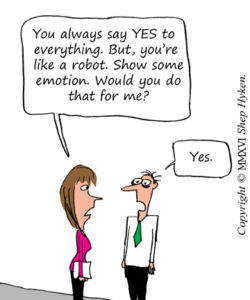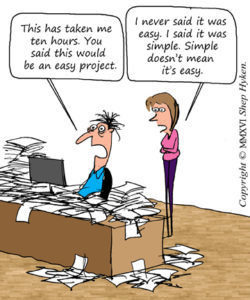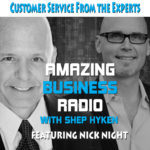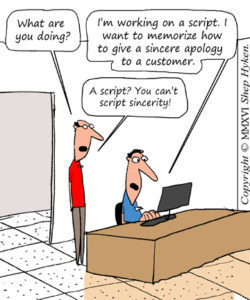Shep Hyken's Blog, page 190
May 4, 2016
Great Customer Service Is More than Just Saying Yes to Every Request
 Personality Traits
Personality TraitsI recently engaged in an online conversation with one of our subscribers, Per Sjofors, and he shared an observation regarding customer service. He noted that even if a company takes care of every request, if its response is lacking in personality, it may not be perceived as good service. I agreed, and we talked more about what I call Stepford Service.
A number of years ago I wrote about the idea of Stepford Service. It is a concept based on the 1972 novel by Ira Levin titled The Stepford Wives, which became a movie in 1975 (with a remake in 2004). The movie was set in the fictional town of Stepford, Conn., where the women were brainwashed into mindless, zombie-like “perfect” wives who lived to cook, clean and take care of their husbands. A new couple comes to town and the wife senses that something is seriously wrong. She is determined to find out what’s going on and make things right. You’ll have to watch the movie to see how it turns out; I mention the movie not because it’s a favorite of mine, but to make a point.
In the movie, the wives were subservient and mindlessly did whatever was asked of them. You might think that if this happened in business, it would be the perfect customer service. The answer would always be “yes,” and customers would be sure to hear, “I’ll take care of that for you right away.”
Yet if the “I’ll take care of you” response is void of personality, in other words, zombie-like and mindless – robotic even – you might appreciate that your request was fulfilled but still not be impressed with the customer service.
The point is that customer service is more than just saying “yes.” It’s more than doing what the customer expects. It’s taking care of the customer with some personality. The personality traits of a customer-focused individual would include caring, empathy, sincerity, cheerfulness, and more. And remember, this isn’t just about the front line – everyone has a customer, whether they are internal or external.
So, how much personality does it take? The customer needs to get some sense of enthusiasm and caring – even a slight demonstration of the customer-focused traits mentioned above can show the customer that you are not just going through the motions. And that may be all that you need.
Great customer service doesn’t mean saying “yes” to every request. It’s a little something more. It’s the personality you put into the experience.
Shep Hyken is a customer service expert, keynote speaker and New York Times bestselling business author. For information contact or www.hyken.com. For information on The Customer Focus™ customer service training programs go to www.thecustomerfocus.com. Follow on Twitter: @Hyken
(Copyright © MMXVI, Shep Hyken)
The post Great Customer Service Is More than Just Saying Yes to Every Request appeared first on Shep Hyken.
May 3, 2016
Amazing Business Radio: Andrea Michaels

Andrea Michaels on Achieving Success and Thriving in a Crisis
Shep Hyken speaks with Andrea Michaels, CEO of Extraordinary Events, Pillar of the Industry award winner, and author on overcoming obstacles and conflict. Andrea shares her story on how she became one of the most recognized event planners in the world and provides lessons on how to properly handle crises. Everyone will encounter conflicts throughout their life. If you want to learn some great lessons on how to handle them, you can’t afford to miss this show!
Click here to listen and subscribe to Amazing Business Radio on iTunes.
“There will always be conflict in any relationship, it’s how you address it that matters.” – Andrea Michaels
The post Amazing Business Radio: Andrea Michaels appeared first on Shep Hyken.
May 2, 2016
5 Top Customer Service Articles For the Week of May 2, 2016
Each week I read a number of customer service articles from various online resources. Here are my top five picks from last week. I have added my comment about each article and would like to hear what you think too.
The Top Personality Traits for Successful Customer Service Associates by Ian Landsman
(HelpSpot) Building a reputation for great customer support requires having employees who reflect the key characteristics necessary to be excellent customer service associates.
My Comment: This is an excellent article about the personality traits you would want in your customer-focused representatives. And beyond customer service, these traits may be important to other responsibilities within a company.
New Social Care Track at Social Media Marketing World Shines Spotlight on Customer Service by Dan Gingiss
(Social Media Today) For the first time in its now four-year history, Social Media Marketing World introduced an entire track at its popular conference dedicated to Customer Service. Consisting of four unique individual sessions and two dynamic panel discussions, the Social Care Track delivered on its promise to sharpen social customer service skills and convince social media marketers that great service is critical to their success, too.
My Comment: Have you (your company) embraced social media customer service? If not, you are going to be left behind. The biggest social media conference in the world felt that social customer care was important enough to create a specific track. And each session was filled. Dan Gingisss gives an excellent recap of the highlights.
Why Nordstrom’s Innovations Insures It Is Supreme in Customer Service by Walter Loeb
(Forbes) Nordstrom recently published its annual report emphasizing its efforts to be on the leading edge of retail innovation. Its devout attention to service, a.k.a. customer care, makes shopping in its stores a delight. Caring for the customer adds momentum to sales and recognizes consumer priorities. Here I outline just a few of the many innovations Nordstrom has been pursuing in recent years.
My Comment: Nordstrom is no doubt a rock star when it comes to customer service. I always enjoy reading articles about how they do what they do so well. This article points out how they are keeping up with technology and innovation. We can all learn from this icon in the customer service world.
Five Top Causes of Customer Attrition (and How to Deal With Them) by Chris Frascella
(Win the Customer) While customer service problems aren’t always your fault, your ability to respond to a customer’s concern is within your control and is the responsibility of your organization.
My Comment: What makes a customer service rep effective at what he or she does? Or, what causes them to not deliver the excellent service experience you hope for? This article shares five reasons a customer support rep may struggle to deliver an amazing customer service.
Hacked: How & When To Use Emojis In Customer Support by Emil Hajric
(Helpjuice) As you can see, the biggest CHALLENGE in customer support today is to humanize the relationship with customers. Here is the twist: Using EMOTICONS/EMOJIS in customer support will make your job so much easier and humanize your relationship with customers online!
My Comment: The use of emoji’s for a rating system has been a little controversial. For example, some social channels gave you the choice to like a post or not. Now you can assign an emotion to your rating. Does it make you happy, sad, mad, laugh, etc. Why wouldn’t a company want to know this? This is an interesting article about how and when to use emoji’s.
The History Of Customer Service by Kelechi Okeke
(CXService360) Customer service as we know it today has taken over 2 centuries to evolve. Merchants, tradesmen even the local butcher and hat makers had begun to realize the importance of creating mediums for their customers to contact and engage with them.
Bonus! It’s not an article, but an infographic that shares some interesting history on how customer service was developed. Think about a time before computers, phones and cars. To have a problem or complaint resolved, you had to show up in person. Today, you just take out your “smart phone.” I enjoyed this adaptation of customer service history, and I hope you will too.
Shep Hyken is a customer service expert, professional speaker and New York Times bestselling business author. For information contact or www.hyken.com . For information on The Customer Focus™ customer service training programs go to www.thecustomerfocus.com . Follow on Twitter: @Hyken
The post 5 Top Customer Service Articles For the Week of May 2, 2016 appeared first on Shep Hyken.
April 29, 2016
Guest Blog: Customer Service Becomes Predictive
This week on our Friends on Friday guest blog post my colleag ue, Jeff Foley, writes about using customer data to create memorable customer experiences and to be proactive in knowing what the customer wants. – Shep Hyken
What do customers want? If companies could predict that, they could demonstrate true customer service leadership.
Forward-thinking organizations are shifting from a reactionary stance to a proactive one. They are preemptively servicing their customers and predicting how, when and where their customers want to be reached. With the right technology and data, service representatives can get ahead of potential customer issues and provide a solution before the customer even becomes aware of the problem.
So, how can companies take advantage of vast amounts of customer data to create memorable experiences that positively impact the company’s bottom line? First, there has to be an understanding as to why this approach to customer service is important.
Customer Data: Beyond Name, Rank and Serial Number
Companies already collect quite a bit of information on customers beyond the standard account information like name, hometown and date of birth. Every customer interaction contains new insights into habits, preferences and issues. Companies can integrate other public information into these customer profiles to form a deeper picture. With social media, each digital interaction provides a fresh chance to better understand the context behind each customer service request.
Despite the riches of information available, most companies don’t know how to apply all this data to improve customer service, let alone use it to truly anticipate customer needs. As the Internet of Things generates even more data from devices, companies risk appearing out of touch with customers. For example, if a customer is calling with an issue about his newly purchased laptop, knowing that customer’s location, the device’s status or which part is malfunctioning can all turn an average service experience into an exceptional one.
Paradoxically, as businesses learn more about customers, they tend to do less to demonstrate what they’ve learned. Despite tapping into increasing streams of customer data, businesses find it difficult to easily access and put to real use. Without that data – much of which is locked away in separate departmental silos – employees repeat warmed-over scripts and enforce redundant policies that ignore what they should already know. Analytics technologies have the ability to sift through that data, pull out insights and guide decision-making in real time, allowing employees to deliver on-the-spot, relevant customer service.
Turning Information into Insight
In this modern world, no one should have to look for insights – the insights should find everyone. Consumers want companies to use the data already stored to anticipate needs and resolve issues as quickly as possible. If an organization uses customer data to gain insights and preempt customer concerns, the following is likely to happen:
Optimize outcomes: Simply put, predictive intelligence increases the chance of success. Modeling old customer behavior leads to new insights on whether to recommend a particular offer, find a workaround or create a satisfying alternative.
Make quick and balanced decisions: Many companies leave key decisions about authorizing credits, settling debts or making offers completely up to the whims of its employees, providing few centralized policies. Organizations should guide employees based on customer data and business goals. This will allow them to eliminate the guesswork out of those service decisions and avoid long delays waiting for manager approvals.
Learn and adapt from past missteps in real time: With adaptive analytics, past interactions can inform future decisions so employees learn over time rather than repeat each other’s mistakes.
Reimagine the future with visualization and simulation: With customer data, a business can simulate the effects of a proposed price adjustment or policy change to forecast results and optimize the response to an issue. This allows businesses to identify the probable outcomes of key scenarios such as, “What if you gave refunds to every platinum customer who complained?”
The Best Metric of Success: The Bottom Line
While most contact centers focus on baseline cost-saving techniques, like reducing handle times and accelerating employee training, they often underestimate the revenue-generating benefits of predictive customer service and classify it as a “phase two” project. However, the benefits may outweigh the cost savings of other initiatives. For example:
Eliminating misroutes: What’s one of the best ways to make a customer feel less frustrated? Predict the reason for a call and direct it to the right department or skilled agent, decreasing costly misroutes and transfers.
Redirecting inquires to self-service: By acknowledging a service disruption and redirecting inquires to a personalized web page for a status update, companies can avoid costly phone calls when notifications and self-service are all the customer needs.
Reducing call volume: Addressing customer concerns before they happen always makes for a more satisfying experience. But more than that, it also reduces inbound call volume if companies can direct customers to more efficient channels for resolving an issue.
If an organization is not moving toward a preemptive customer service model, it may soon feel the heat from customers getting better service from more forward-thinking companies.
Changing to this model begins with a few immediate steps. First, identify the thorniest customer journey trouble-spots to determine where to find quick wins. Determine a metric that reflects success for that journey – for instance, one telecommunications company chose to focus on reducing the total number of customer touches during a change of residence. Start by using real people to track those journeys until an understanding is gained around which legacy systems and processes to improve or replace. From there, begin to apply customer data to make smarter decisions and anticipate customer needs.
Finally, make sure that preemptive service using customer data sits as the centerpiece of the company’s digital transformation plans over the next three to five years.
Jeff Foley is a Product Marketing Director at Pegasystems. As an MIT engineer-turned-marketer, Jeff aligns sales, marketing, and product organizations to deliver software customers love. (Twitter: @jjfoley)
A version of this post appeared on CMS Wire .
For more articles from Shep Hyken and his guest contributors go to customerserviceblog.com .
Read Shep’s latest Forbes Article:
There’s On Time And There’s Lombardi Time
The post Guest Blog: Customer Service Becomes Predictive appeared first on Shep Hyken.
April 27, 2016
Simple Doesn’t Mean Easy
 Customer Service is Simple
Customer Service is SimpleMy belief is that customer service is simple. At least it is on the surface. It can be as simple as just being nice to a customer. Being nice, showing empathy, being sincere – these are some of the basics of customer service, and they seem pretty simple. Of course there is much more to delivering an amazing customer service experience than just being nice, but that’s a pretty good start.
So, let’s get back to the concept of simple. Changing a company’s culture is not easy, yet I preach the concept of Six Simple Steps to Creating a Customer-Focused Culture. Are they really simple steps? Yes, but that doesn’t mean they are easy.
Simple is about understanding. Being easy is about execution.
While something as simple as being nice might be easy for some, there are concepts, strategies and tactics about customer service that are not.
One day I was presenting to a group of C-Suite executives. The topic was about the culture of the company, and I was covering the six simple steps mentioned above. After going through the six steps, one of the audience members raised his hand and asked, “How long will it take to implement these six steps in my company?”
I responded, “How many employees do you have?”
He said there were about 30,000 employees. I told him it could take four or five years, even longer.
He was shocked and said, “You said it was simple!”
And, I replied, “I did say it was simple, but I didn’t say it was easy. As a matter of fact, it is hard.”
I believe that most people know what customer service is. Some even say its common sense. People know what excellent – even outstanding – customer service is. That doesn’t mean they are capable of delivering it. Their personalities may not be in alignment with the company’s values and goals toward customer service. Maybe their jobs don’t typically require it (although I believe that just about everyone has at least internal customers that need to be serviced).
The companies that put forth the effort to be better than average or satisfactory win. They hire good people and train them well. As simple as that sounds, it does take effort; sometimes lots of effort. Hey, if it was easy… everyone would be doing it!
Let’s really simplify this with a non-business example. Going on a diet is a perfect metaphor for the concept that simple isn’t easy. I decided that I wanted to lose five pounds. My wife offered up some simplistic advice and said, “That’s easy. Just stop eating so many desserts.” The problem is, it’s not easy. You see, I love desserts, but her advice makes sense. If I want to lose weight, just eat healthier. Simple! Then why is there a multi-billion dollar diet industry to help people lose weight? Because it’s not easy… Yet it sounds so simple!
Shep Hyken is a customer service expert, keynote speaker and New York Times bestselling business author. For information contact or www.hyken.com. For information on The Customer Focus™ customer service training programs go to www.thecustomerfocus.com. Follow on Twitter: @Hyken
(Copyright © MMXVI, Shep Hyken)
The post Simple Doesn’t Mean Easy appeared first on Shep Hyken.
April 26, 2016
Amazing Business Radio: Nick Night

Nick Night Shares a Revolutionary Way to Add Value for Your Customers
Shep Hyken discusses marketing and sales with, CEO and Co-Founder of Revizzit, Nick Night. They discuss creating your 21st century fan club by offering exclusive content through untraditional means. Nick shares some great ideas and tactics he uses within his company – ideas that everyone can apply to their businesses. You’ll also learn about Revizzit.com, a publishing platform that is revolutionizing the publishing industry and is an outstanding way to provide value to your customers. The result adds value to your customer’s experience and helps create customer loyalty. (And, who doesn’t want that!)
Click here to listen and subscribe to Amazing Business Radio on iTunes.
“Once someone purchases something from you, they should be part of your inner circle, you want to reward that relationship and keep giving them value.” – Nick Night
The post Amazing Business Radio: Nick Night appeared first on Shep Hyken.
April 25, 2016
5 Top Customer Service Articles For the Week of April 25, 2016
Each week I read a number of customer service articles from various online resources. Here are my top five picks from last week. I have added my comment about each article and would like to hear what you think too.
Why a Negative Customer Experience Isn’t the End by Jillian Misner
(Contactually) Taking criticism and turning it on its head so you establish yourself as an understanding and reliable professional will actually strengthen your relationship. It may not sound easy, but with the right approach you won’t have to worry about a negative review or sour memory again. Take control of all types of business relationships by healing bruises most effectively.
My Comment: It’s not “if” your customer will ever criticize you or give you negative feedback. It’s “when.” And, then it’s what you do about it that counts. Here are some ideas on how to turn that negative feedback, as the author says, “on its head.”
Speed Read: How to Make Your Customers as Loyal as Your Dog by Noreen Seebacher
(CMSWire) Customers are always loyal … unless they can get whatever it is you’re selling faster, cheaper or more conveniently. They may even give your competitor their business in exchange for intangibles like greater empathy or more smiles.
My Comment: This is a short and to-the-point article. Three quick tips on building customer loyalty. The title intrigued me. It’s said that a “dog is a man’s best friend.” Well the customer could be the business’s best friend – if you treat them right.
7 Tips to Stay on Top of Social Media Customer Service by Paul Johns
(Jeff Bullas) Here’s a compilation of tips for navigating this relatively new but rapidly growing space.
My Comment: I just came back from the Social Media Marketing World conference where they devoted an entire track to social media customer service. It is more important than ever to have a social care strategy. Here are seven tips to get you thinking about it.
The Chutes and Ladders of Customer Loyalty by Needle
(Needle) Building customer loyalty can be a game of Chutes and Ladders for marketers – especially for those in online retail. There are plenty of ladders and best practices to climb the board, but beware of pitfalls!
My Comment: This isn’t an article, but an infographic with some interesting stats and facts about customer loyalty and ecommerce. Even companies that don’t do much in the ecommerce world should find the information interesting. It’s always important to get insight into what customers (B2B and B2C) are thinking.
5 Proven Growth Strategies From CX Experts by Cvetilena Gocheva
(CustomerExperience.io) CustomerExperience.io has collected five of the best practice tips from CX top leaders to help companies maximise on their customer experience investment.
My Comment: Five business experts weigh in with their tips on customer service and experience. Nothing fancy here. Just good common sense, that may not always be so common. Touch points, an effortless experience, delight, feedback and leadership; great reminders and suggestions on how customer service and experience can grow your business.
Shep Hyken is a customer service expert, professional speaker and New York Times bestselling business author. For information contact or www.hyken.com . For information on The Customer Focus™ customer service training programs go to www.thecustomerfocus.com . Follow on Twitter: @Hyken
The post 5 Top Customer Service Articles For the Week of April 25, 2016 appeared first on Shep Hyken.
April 22, 2016
Guest Blog: Utility Companies Help Customers to Help Themselves: The Pay-As-You-Go Revolution
This week on our Friends on Friday guest blog post my colleag ue, Dan Goss, shares an example of what one utility company is doing to change the way customers pay their bills, making it customer friendly and giving control to the customer. This is a very interesting look at a pay-as-you-go model and I look forward to hearing if it is successful. – Shep Hyken
Across the world, a revolution is taking hold of the companies that provide our electricity, our gas, and our water. These utility companies have always worked on the premise of charging customers for energy and services they have already used, meaning that many customers have been confronted with nasty shocks and unfortunate surprise charges when their bills came through – and with the energy already spent, there was nothing those customers could do about it.
This method of billing customers created a few problems from the customer service team’s points of view – first off, as mentioned above, was the fact that the customer had already expended the resource they were being charged for, and could therefore do nothing to alter their bill this time.
Second was the fact that unless customers are skilled at reading their home meters, they are unlikely to even know how much they are spending on electricity and gas throughout the month until the bill comes round, so adjusting their level of usage might be difficult. The result: overcharged, unhappy customers.
These problems are being tackled head on by the utilities industry in a very unusual way – with a complete overhaul of the way utilities billing works. Many companies, such as Utilita or United Utilities in the UK are implementing a pay-as-you-go “smart meter” system that allows customers much more control over their utility expenses and means much more can be done by the company to help customers who are encountering problems.
The systems work exactly the same way as a pay-as-you-go mobile phone tariff, with customers “topping up” their home utilities meter and receiving the amount paid for in usable power and gas. The top-ups can be done via a card at designated stores, online, or over the phone, and with many of the companies the customer’s meter will update automatically as soon as the transaction is complete!
The customer can then use their credit at whatever rate they choose, and since they have paid in advance, they are in control of their spending and can’t be surprised by a bill. The ball is in their court, rather than the company’s, which means a much better relationship between customer and company.
This control over the amount used is a two-edged sword, however. Since these pre-paid tariffs carry a limit on how much can be used, they carry the risk that the customer may not budget their usage well and be left without power or gas at a time when topping up is difficult or impossible. The utility companies are kicking their customer service up a notch here as well, with systems designed to keep the lights on and the customer smiling when they need it most.
For example, the company mentioned earlier, Utilita, has two ways to help the customer avoid running out of credit, even when the stores are closed or the lines are down. The first, “Emergency Credit,” is £10 of credit available any time, to keep the lights on through the night or the gas flowing even in dire circumstances.
The second is “Friendly Credit,” which is available every day between 4pm and 10am, keeping the customer on supply through the night in the event that they have underestimated their usage. Both of these systems are in place to help prevent the customer being caught out, for whatever reason, and help provide an excellent, reliable service at any time. All of it is underscored by the smart meter itself, which provides an easy-to-read screen in the customer’s home, telling them how much credit they have remaining, how much they’re using, and a wealth of other information. Knowledge is power, and this setup is all about power to the customer.
With these changes in place, it’s clear a paradigm shift is occurring in the world of home utilities. The industry is shifting away from leaving customers dreading their next bill, unable to change what has happened, and embracing a future where the customer knows how much they need, how much they’re paying, and how much power they really have.
Dan Goss is the editor, writer and primary researcher at Customer Service Guru. In his spare time he writes, reads, and writes some more. He can be found at your nearest coffee machine or at the customer service desk at your local department store, frowning.
For more articles from Shep Hyken and his guest contributors go to customerserviceblog.com .
Read Shep’s latest Forbes Article:
The 10 Best Ways To Hire For Customer Service (And Almost Any Other Job)
The post Guest Blog: Utility Companies Help Customers to Help Themselves: The Pay-As-You-Go Revolution appeared first on Shep Hyken.
April 20, 2016
You Can’t Script Sincerity in Customer Support
 Customer-Focused
Customer-FocusedIt’s not that hard to notice when you’re dealing with a customer support rep who is less than sincere. They tend to say some of the same things over and over, such as, “I can understand why you would feel that way and we are sorry for your inconvenience.” It’s as if they are reading from a script… because most of the time they are. I actually had one customer service representative repeat that phrase so many times that I asked them to not to say it anymore.
They aren’t really sorry. At least they don’t appear to be. What they appear to be doing is regurgitating the responses they learned in their customer service training classes or what’s printed on a piece of paper. Maybe they really are sincere; but their company forces them to appear to be insincere, because they are required to go by the script.
The bottom line is this: You can’t script sincerity!
The best customer support people, leaders, co-workers – really anyone you work with – don’t get to be the best by being fake or insincere. No, they have empathy, concern, and genuinely care about who they work and do business with.
And, if you can’t script sincerity, you probably won’t be able to teach it either. If people aren’t cut out to be empathetic and caring, you probably won’t be able to teach them, at least not before they potentially do damage to the relationship with the customer.
That said, some people can fake sincerity, at least for a short time. Eventually the effort and pressure to be someone that they’re not will catch up with them, and can manifest itself in potentially angry behavior. That’s why some employees lose their cool. It’s not that these people aren’t nice. It’s just that their personalities don’t have the patience or empathy needed to deal with confrontational customers, especially if they are upset and acting unreasonable.
The bottom line is that insincerity is a loyalty killer. And, while they may put up with it, customers shouldn’t have to deal with a customer support rep who is scripted, apathetic, and isn’t customer focused. How can a customer have a positive emotional connection to the company if the employees come off as fake or insincere?
So, how do we go about getting good, caring people? It starts before you even hire someone. The leadership has to define what good customer service looks like in the organization. Once defined, you hire good people who can support that initiative. Then you train them. Accolades from leadership for a job well done makes employees feel good, especially after handling complaints and problems on many of their support calls.
Getting great people who are customer-focused is of the utmost importance. (I recently wrote an article on ten ways to hire the best people for customer service for Forbes.)
The best customer-focused people care. They have empathy, sympathy, patience, tolerance, understanding, passion and, of course, sincerity. So hire customer service reps that care, and who already have the personality to succeed in a customer service position.
Shep Hyken is a customer service expert, keynote speaker and New York Times bestselling business author. For information contact or www.hyken.com. For information on The Customer Focus™ customer service training programs go to www.thecustomerfocus.com. Follow on Twitter: @Hyken
(Copyright © MMXVI, Shep Hyken)
The post You Can’t Script Sincerity in Customer Support appeared first on Shep Hyken.
April 19, 2016
Amazing Business Radio: Karin Hurt & David Dye

Karin Hurt & David Dye Share a Practical Action Plan
for Being a Better Leader
Shep Hyken speaks with Karin Hurt, Leadership speaker and CEO at Let’s Grow Leaders, and David Dye, award winning author and owner of Trailblaze Inc., on leadership. Karin and David share techniques from their new book, “Winning Well: A Manager’s Guide to Getting Results—Without Losing Your Soul.” Their focus is on developing people. They show you how to escape the metric maze and focus on getting better results AND building stronger relationships.
Click here to get their book “Winning Well: A Manager’s Guide to Getting Results—Without Losing Your Soul” on Amazon.
Click here to listen and subscribe to Amazing Business Radio on iTunes.
“Lead from who you are, trust your instincts, and lead authentically.” – Karin Hurt
“Every interaction you have should focus on both results AND relationships.” – David Dye
The post Amazing Business Radio: Karin Hurt & David Dye appeared first on Shep Hyken.



